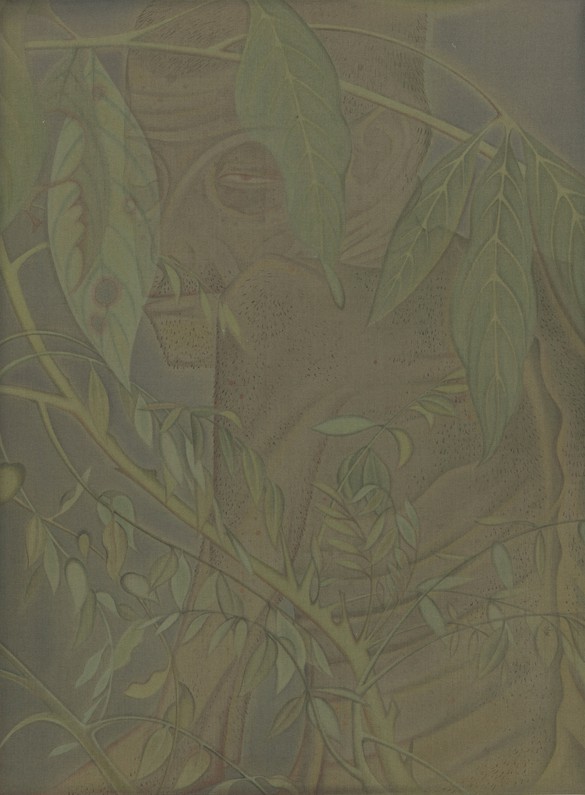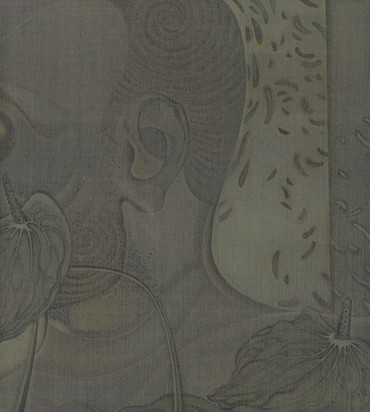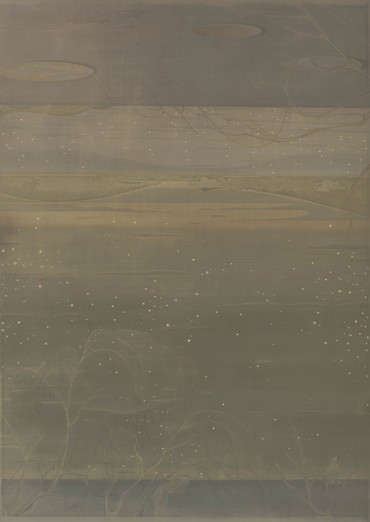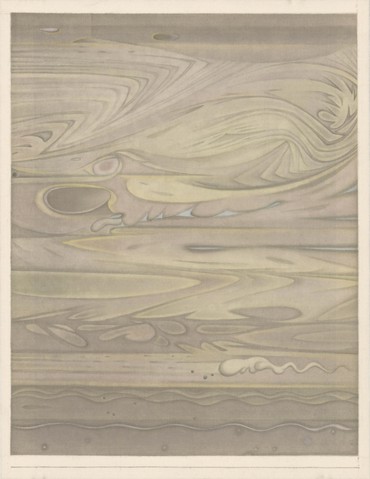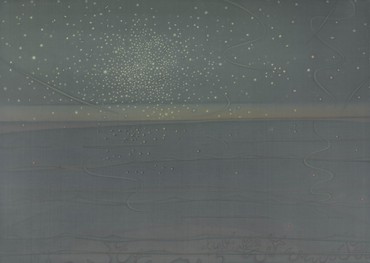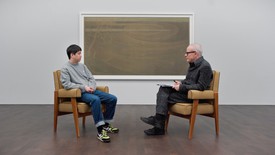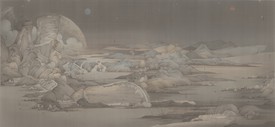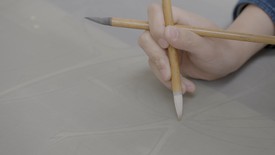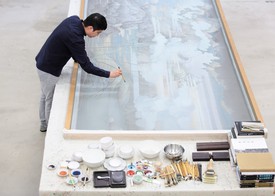
Travis Diehl is a critic, writer, and editor. Recent reviews and essays of his have appeared in the New York Times, Artforum, Art in America, x-tra, Frieze, the Financial Times, and Tank; recent poems have appeared in Forever. Awards he has won include the Creative Capital Arts Writers Grant and the Rabkin Prize in Visual Art Journalism. He is Online Editor at x-tra.
1
Here’s a contemporary experience: one of Hao Liang’s new paintings reminds me of a joke I remember seeing a stand-up comic tell on TV. You’re on an elevator, alone, maybe in New York or London or Beijing, ready for a private moment, when someone slides between the closing doors. You can’t help but notice it’s Jack Nicholson, and he doesn’t look so good—he’s haggard, collar lopsided, two days of beard, big black shades hiding what you can only imagine are bloodshot eyes. But he’s looking you up and down, too, and it’s him that says it: “You look,” he says, “like I feel.” I was a kid when I heard that joke, and I didn’t get it.
2
The painting, a gauzy portrait set in a gossamer jungle, is called Spring and Emaciated Horse (2022). The figure doesn’t look so good. He looks like I feel. He’s gaunt and cardboard skinned, ribs showing like a pig’s, rash-colored pupils sliding between their wrinkled, closing lids. Even his arms are prickly with stubble. He peers resignedly over his shoulder, as if spotted in the act of simply existing. The figure seems almost guilty to be there in the roiling new life, among leaves so delicate his outline shows through, caught out naked in the forest in a painting that should be about spring and thin horses but is now about him, his emaciation and equine aura, his being beaten and saddled.
3
Hao’s guohua technique, based on centuries of paintings in ink and mineral pigment on silk, heightens the ambivalence of his subjects; his tight tonal range, flecked with highlights of bare fabric, flirts with abstraction or at least offers a kind of mist in which figures and buildings can hide. Hao’s paintings are about reaching for feelings that can’t be described any other way—they convey a mix of humor, distress, resignation, awe; a taste for deep human themes; the feeling that to be alive today, to be contemporary, to be of multiple times, is to feel out of joint—lost in the right place.
4
A smaller work from the previous year, From Assyria to the Beijing Botanical Garden (2021), reads like a precursor or companion to the emaciated man. The guy here doesn’t look so good either—his whole face seems bloodshot, although the edge of the painting clips off most of his features. The lily against his cheek resembles an organ more than a flower, bulging with veins, the pistil like a bone. He looks like I feel—he is one of my contemporaries, with me in this slice of time, riding into eternity. As with most guohua, the painting looks through history or histories in order to find the present—to resurrect the deranged population of the contemporary, their skeletons like scholars’ rocks. The swirls in his haircut and beard are like water stirred clockwise.
5
Under a Tree in Britain (2022) features a lake. The trees are off to the side. Most of this large painting—three yards or almost three meters wide—is consumed by the feathery arms of a whirlpool. It’s not in the lake, exactly—there’s no funnel or abyss—more like a labyrinth etched on the water’s surface, a lazy, confident spiral. A fantastic philosopher monk, with claws and a tail, stands under the leftmost tree. A lean dog stalks toward the shore. A young man with red hair strolls along the bottom edge, although we see him only from the waist up. Maybe he contemplates the branches full of birds before him or the flurry of golden leaves behind him, oblivious at any rate to the catastrophe unfurling on the water and his contemporary under the tree.
6
Hao knows the labyrinths of Jorge Luis Borges. Borges wrote “The Garden of Forking Paths” during the Second World War but set it during the First. The narrator of that story, a Chinese national teaching in England, serves as a spy for the Germans; in his last act before he is captured, he murders a sinologist named Albert and thereby sends a message to the enemy to bomb a town by that name. Before he pulls the trigger, however, Albert—by coincidence? no, contemporaneity—reveals that he has long studied the work of the narrator’s ancestor. This inheritance, an elaborate labyrinth, takes the form of a novel in which every choice unfolds simultaneously, branching out, indefinite and confounding. The labyrinth is the contemporary.
7
Hao’s work borrows freely from past styles and innovations. Modernism, psychedelia, photography, all needed to happen in order for him to make his paintings. So, too, did Tang poetry and guohua silk painting. His work would be postmodern if it weren’t so vast and insistent. Hao’s painting doesn’t pick and choose; it isn’t pastiche but rather a maze of concurrent paths, so that several eras might take place on the surface of the silk. Hao’s paintings have a grandiloquent scope that seems almost inappropriate to the twenty-first century, more proper for the nineteenth or the ninth. Maybe all these centuries at once. There’s humor there, too—in the absurdities of anachronistic meet-cutes, like a modern man about to meet an animal monk among the Paul Klee trees.
8
It’s contemporary to dip back into the past and to look to the future. It’s uncontemporary to live entirely in the present, resisting the pull of other times. In Hao’s work, historical reference and present realism and futuristic speculation wear ambiguous clothes; his painting names the contemporary as a state of temporal ambivalence. In the vertical painting called A Thread of Sky (2021), two figures hug the bottom edge; one hunches against the wind or maybe against gravity; the other, a kind of medieval man-beast, perches in the branches—and notices, where the bent figure doesn’t, the other horizon looming opposite theirs, with what could be modern buildings and the sawtooth symbol of a factory roof in the hills. This second foreground, set off by a band of sky, could almost be its own planet, crashing into another. At the top of the painting, along the bottom of the inverted ground, is an astral landscape, each crisp crater holding clouds or kinked crags, another swirling little multiverse.
9
In Chinese art history, artists have returned to the same subject again and again as a rule—cycles of paintings of a particular mountain across seasons and moods, a series of poems remarking on a given river valley, or a whole career spent observing, depicting, responding to bamboo. Hao has approached these modes in the past—he’s painted his share of sweeping landscapes and tangled groves. Here, he spends three small horizontal paintings returning to the poetics of the Tang bureaucrat and poet Li Shangyin. It’s one thing to depict a mountain, but how does an artist depict a poetics? It’s like returning to history, in which events won’t change, although their retelling might, and the feeling we find in them changes every time.
10
The three paintings float near abstraction, grounded by flecks of figuration. They almost form a series, a descent. Poetics of Li Shangyin I (2021) starts in space: a crescent moon, halos around the stars, cloudlike striations and the moon reflected on the cratered water. II dips into the sea; a concentration of confetti resembles a galaxy through a telescope or bacteria on a microscope slide. A ruffle of coral runs along the bottom edge. In III, ranks of raindrops lance the surface of the picture, and water covers most of the composition; a pair of pale puffballs or tumbleweeds, their scale uncertain, catch the eye, but an octopus controls the painting from behind a shell, and two corners of land, maybe submerged, pin the composition to art history.
11
Ambivalence and ambiguity aren’t quite the same thing, although one often prompts the other. Li’s writing is famous for obscure references and unusual imagery, a mix of banal particulars of Tang life and crystalline images of nature. In Hao’s new paintings, I’m not always sure what I’m looking at, and that feels right. If the idea is to read a guohua painting, unpacking the number and kind of birds and branches or punning on the words for “carp” and “profit,” it’s not so easy to put words to Hao’s paintings. The imagery is ambiguous; the paintings’ poise between the past and the future declares the ambivalence of contemporary life.
12
Holding up my iPhone to a book of Li Shangyin’s poetry, I watch Google Translate butcher the Chinese syntax. Instead of the evocative lines given by Chloe Garcia Roberts, Li’s foremost contemporary translator, my phone produces garbled little pads of text, crammed into the poem’s grid of characters. This wronged language has its own kind of poetics: where Roberts and others write “miscellaneous notes,” Google puts “miscellaneous diamonds.”
13
Nostalgia can be dangerous, especially so-called nostalgia for the present, as if there’s not simply the feeling of something missing but the rising demand that this lack deserves appeasement. But the lack belongs to the contemporary. The joy of new life comes with the sadness that you might not live to see its full flower. It’s all a little too much. Hao’s All Things (2022) is a relatively small painting with a constrained palette of creams and ochers. Yet within this range, its variegations display a compendium of forms, like strata twisted by eons of earthquakes and new mountains, a gallery of possible lines, squidges of life trapped in there forever. The painting incorporates, somehow, in its “All,” the as-yet-unaccomplished fact of its destruction.
14
We see most of Hao’s epic Divine Comedy II (2022) through a chain-link fence. There’s a snake coiled among the bare, stoic tree trunks. A figure from an ambiguous time walks with their head down, wrapped in winter coat and scarf: hell looks cold. A couple of demons perch in the branches; one brandishes its wings. The figure doesn’t seem to notice. The fence obscures the scene, but it’s also part of it, an extension of or metaphor for the substrate, the densely woven silk threads, as if we’re zooming in on a cotton shirt in a detergent commercial, suddenly aware of the oils and germs inhabiting our clothes, perched on the fibers like demons. The painting is a permeable microcosm. To the left of the composition, a patch of inky fire seems to break through the fence and spill toward us, out of the picture. It makes me think: “chain ink.”
15
Me in New York, Hao in Beijing, his paintings and my text in London: does this text convey the feeling of several places and times at once, of quoting history but also imagining—not even distant relatives or future historians—but simply Hao Liang or the people who see his paintings reading it at some point in the near future? Is Hao my contemporary? If so, I’m the one in the leaves.
16
The figure wrapped in a robe, emaciated almost to the point of abstraction, leans back against the left edge of the painting. Behind him are maybe the bars of a jail cell, but they’re incomplete; it feels like he could escape if that were what he wanted. To the right, loops of razor wire garnish the sill of an open window with a view onto a kind of surrealist cartoon, a wet crater, a perfectly round eyeball on the horizon near a trio of tall mushrooms. Fire licks up the wall. A couple of the tongues of flame resemble the beads in a lava lamp, only with grinning faces. The painting is called Poetics of Spring in Jiangnan in Year of Renyin (2022), nodding to a verse by Du Fu, another Tang poet, in which his contemplation of a landscape leads him to imagine all the once vital temples now abandoned in the fog. It’s a poem about the sadness of empires passing. The poet says of the landscape, “You look like I feel.” But I prefer—and I think Hao might, too—the way Li Shangyin surveys the ruins of the past in a poem Roberts translates as “Twisting River.” “Heaven became a wasteland,” Li writes. “My heart foundered.” Then he flicks his slender poem into the gulf of the contemporary: “Yet compared with the anguish of spring,/this means almost nothing.”
Hao Liang: The Sad Zither, Gagosian, Grosvenor Hill, London, February 9–March 18, 2023
Artwork © 2023 Hao Liang Studio
